Beverly Gray's Blog: Beverly in Movieland, page 2
August 1, 2025
Bob Mackie, Naked?
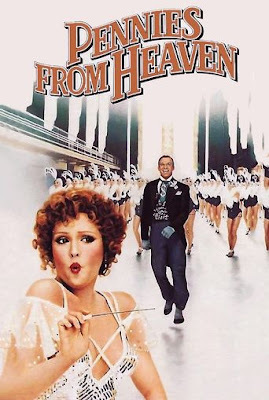
I met Bob Mackie circa 1981,on the fabled MGM studio lot. We were on the set for Herbert Ross’s ambitiousmusical, Pennies from Heaven, starring Steve Martin and BernadettePeters. They played dreamers who (almost) survive the Great Depression byfantasizing about living lives filled with music, dance, and luxuries likespectacular clothing. Needless to say, this was a dream assignment for Mackie,whose chief claim to fame at the time was his flamboyant duds for TV divas likeCarol Burnett and Cher.
As a big fan of the CarolBurnett Show, I asked the amiable blond Mackie (wearing a polo shirt andlooking like a kid) whether he was responsible solely for the lavish gowns inwhich Burnett greeted her weekly studio audiences. In fact, he explained, hedid everything related to costuming for the long-running weekly variety show.This meant bunny suits for the dancers, when needed, and goofy garb for Burnettin her various skits. It turns out—as Burnett herself is quick to admit—that itwas Mackie who came up with the crowning sight-gag in a movie parody of GoneWith the Wind that got one of the show’s all-time biggest laughs. Burnettplays Scarlett O’Hara, forced to greet a post-war Rhett Butler in a dresshastily crafted from her plantation’s green velvet curtains. When she waftsdown Tara’s majestic staircase, viewers can’t help guffawing: her home-madegown still retains its original curtain rod.
Burnett is one of many celebsinterviewed by Matthew Miele for his lively 2024 documentary, Bob Mackie:Naked Illusion. Its title refers to the tantalizingly sheer sheath gownsdesigned by Mackie first for Mitzi Gaynor and eventually for Cher, who—with herscintillatingly slender figure—has been perhaps his ultimate muse. His glitterygowns hint at nudity but leave the wearer’s private areas discreetly covered,though oh so sexy. For Mackie, all this now-you-see-it-now-you-don’t glitz isfun to design, and has led him to costume everyone from Vegas show girls toBarbie. Another of his more unusual clients in Elton John, who encouragedMackie’s outrageous side, allowing him to come up with a Donald Duck ensembleand an Amadeus-style frock coat, as well as a sequined baseball uniformfor a sold-out concert at Dodger Stadium.
It's clear that Mackie adorespretty women (and pretty men like RuPaul), but in fact he seems to like prettymuch everyone. The documentary carefully hints at his sexual orientation, butalso shows homey scenes of the now-eighty-plus-year-old Mackie (grey-haired butstill boyish) cozily hanging out with his recently-discovered granddaughter andher children on a sunny patio. (His son Robin, a Hollywood make-up artist, diedin 1993 at age 33 after an apparently turbulent life.) Though he dresses topstars, Mackie seems wholly comfortable—even overjoyed—to be dressingconservatively and blending into family surroundings.
Mackie’s talent for glamourhas earned him fame and fortune, as well as many accolades from his peers. (Thefilm opens with him modestly accepting myriad awards from fellow designers andcritics.) But the top Hollywood honors have eluded him. He has three long-agoOscar nominations—for Lady Sings the Blues, Funny Lady, and Penniesfrom Heaven. In the documentary, Carol Burnett expresses outrage that the1982 Oscar for costume design went not to Pennies from Heaven but to theyear’s big film, Chariots of Fire. In this well-crafted period OlympicGames drama, veteran designer Milena Canonero’s cast mostly wear track suits that look like long underwear. Ah well! I guess no one can win them all.
July 29, 2025
Not So Superman
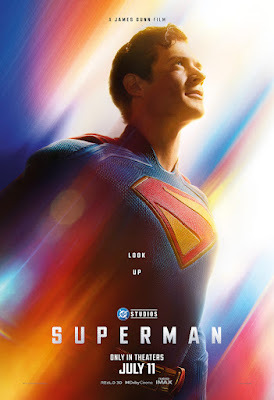
I admit it: there are times Ifeel pop culture has left me in the dust. Am I just too old to have fun? I hadheard many good things about the latest Superman film, written anddirected by James Gunn, whose Guardians of the Galaxy had amused me agreat deal. My tastes tend to run toward the intellectual, but—for a complete changeof pace—I do enjoy extravaganzas with a side order of goofiness.
And everything I read aboutthis particular Clark Kent/Superman combo seemed hugely appealing. I liked thefact that Gunn had apparently chosen to sidestep the angst-ridden, cynicalSuperman of several recent iterations and made HIS superhero a bit of a dork,or at least a gentle, upstanding guy with slightly old-fashioned tastes.
It sounded interesting, in thisday and age, that as a result of Lex Luthor’s machinations this Superman wouldcome to be reviled by the public as an alien, a dangerous representativeof another culture who has illegally invaded Earth. (The complaints in somequarters that this Superman is too “woke” don’t make much sense, in that Gunn’ssuperhero is far more connected with his folksy midwestern adoptive parentsthan with the pair who sent him to Earth as their own planet facedannihilation.)
I also heard many plauditsfor Rachel Brosnahan’s Lois Lane, as a worthy successor to the smart, spunkyMargot Kidder back in the Christopher Reeve days. I too was impressed byBrosnahan (who, with her throaty voice, SOUNDS like Kidder, but has a contemporarysassiness all her own). The surprise in this version is that she knows fullwell about Clark Kent’s secret identity, and is not above questioning hisvalues and his methods—in the name of journalistic integrity, you understand.Spoiler alert: she concludes that she’s really into him, despite it all.
But I can’t agree with thecritics and fans who have oohed and aahed over the presence of the wonder-dogKrypto. Gunn apparently got the idea for inserting Krypto into the story afterhe himself adopted a pandemic rescue dog with a great talent for screwingthings up. Gunn’s tales about the exploits of his own computer-eating Ozu arehilarious, but I felt no particular affection for the clearly animatronicwonder-pup who nearly kills Superman while trying to come to his rescue. (Yes,this Superman needs rescuing more than once: we first see him immediately afterhis first-ever defeat by a superhuman bad guy, and he seems to get knockedaround a lot.)
So what’s the gist of thisparticular Superman film? I’ve heard critics say joyfully that this isthe Superman of their comic-book-centric childhoods. For me, alas, it’sa loud, long, noisy bounce from midwestern corn (in all senses) to eerie Arcticwasteland to ravaged metropolis to a futuristic “pocket universe” gulag enteredthrough a desert campsite where all of Lex Luthor’s minions wear cheery Alohashirts. I couldn’t always follow it. Nor, honestly, did I want to.
The comic-book world ofsuperheroes has been with us since the 1930s. For young boys, in particular,characters like Superman, Batman, and Captain America have promised vicariousadventures and a well-developed sense of right vs. wrong. Hollywood in recentyears has benefitted hugely from its superhero connections, and—with movieattendance now flagging—
this year’s Superman andFantastic Four flicks are much needed. But why does it all have to seemso silly? (I’ve just learned that James Gunn began his career with LloydKaufman’s Tromeo and Juliet, full of severed limbs and possibly thestupidest film I’ve ever walked out on.)
July 25, 2025
Girls Gone Wild: Appreciating “Dance, Girl, Dance”
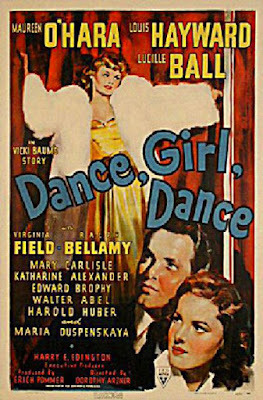
Until recently, I had neverheard of Dance, Girl, Dance. This 1940 dramedy about two New Yorkchorines who are roommates and (sometimes) close friends, is hardly Hollywood’sfinest hour. It was produced by RKO, one of the less prestigious studios of theindustry’s Golden Era, though a place where a number of major talents—thinkCary Grant, Katharine Hepburn, and theAstaire-Rogers duo—got their start. Its two female leads were also on their wayup: Maureen O’Hara plays the sweet, sensible Judy (though she’s eventually to unfurla wild Irish temper): all she really wants to do is to burnish her skills as aclassical dancer. Her counterpart is Bubbles, played by a blonde and brassyLucille Ball as a gal who’ll say or do anything to make her way in the world.Of course they both fall for the same guy, though for very different reasons .. . and he turns out to be not worth having. Hijinks (including what we in theCorman world would call a rip-roaring catfight) ensue.
So why was Dance, GirlDance inducted in 2007 into the National Film Registry of the Library ofCongress? Clearly this has to do with the rising reputation of its director,Dorothy Arzner. Arzner, who from 1927 to1943 was the only female director in Hollywood, got her start back in thesilent era. She entered the industry as a typist, thereby getting a close lookinto how scripts are constructed, then moved into the editing suite. Asdirector she was responsible for about twenty movies, some of which have beenlost. The first woman to helm a sound film, she invented the boom mike (atfirst a microphone attached to a fishing rod) as a way to improve the soundquality of Clara Bow’s first talkie, 1929’s The Wild Party. She was ultimatelythe first female member of the Directors Guild of America.
The Criterion DVD on whichI’ve just watched Dance, Girl, Dance pays tribute to Arzner via twofascinating extras. Film scholar B. Ruby Rich (whom I’ve had the pleasure ofinterviewing about women and sex in the films of the 1960s) hails Arzner as acompetent and confident talent who was particularly smart on the subject ofgender politics. Apparently skeptical about conventional marriages (the one in Dance,Girl, Dance is a doozy), Arzner seems happiest when focusing on thesupportive relationship between women. In this film she also powerfully takeson the ”male gaze” in a scene wherein O’Hara’s character, accustomed to beingogled and laughed at by the lascivious men in her nightclub audiences, turnsthe tables. Never one to hide her own lesbianism, Arzner—who had cropped herhair short and wore man-tailored suits—made sure we sympathize with her femalecharacters, no matter what they wear and what they do for a living.
The second featurette on theDVD stars director Francis Ford Coppola, who was one of Arzner’s students aftershe retired from filmmaking and joined the graduate faculty at UCLA. Coppola remembers “Miss Arzner” as both smart andgracious: she had a habit of bringing to class cookies that were muchappreciated by impoverished film students, and she even once treated him to asimple lunch that felt like a life-saver. This was not the only nourishment sheprovided. Disheartened and broke, he at one point considered giving up hisfilmmaking dreams and returning to New York. In the nick of time she persuadedhim not to lose heart, that he was going to make it as a film director. And, ofcourse, he did.
July 22, 2025
Disney on Land and Screen
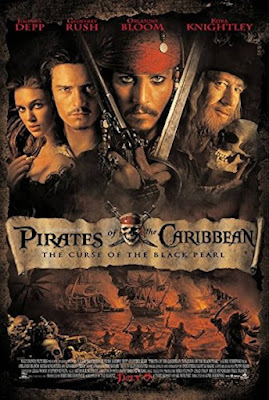
I will never be too old to love Disneyland, the pioneeringtheme park that opened in Anaheim, California just over seventy years ago, onJuly 17, 1955. How well I remember my first visit when the park had been open lessthan six months. I went with my best friend and her parents; her father likedto set out at the crack of dawn, so we were there when the gates opened, andhad to leave—alas—long before all those magical lights came on.
What I remember best from that first visit was all theattractions of Fantasyland, reflecting the fairytales that were so much a partof the Disney brand. There was the dizzying Alice in Wonderland Mad Tea Partyride, of course: the whirling oversized teacups were great fun for kids but wereavoided by queasy grown-ups. And the King Arthur carousel, which turned out tobe just an eye-catching merry-go-round. The big scare ride of that early erawas, of all things, the Snow White attraction. You waited in a long line forwhat seemed like hours, in order to be frightened (or attempt to be frightened)by a dark ride that lasted perhaps three minutes. Some of Disneyland’s bestattractions—like Pirates of the Caribbean, the Haunted Mansion, the Matterhornbobsleds, and Big Thunder Mountain Railroad –were not yet in place, althoughthere was a slow-moving mine train inching through the same basic Southwestlandscape that hearty park visitors whizzed past years later. And Tomorrowland,which advertised a trip to the moon, was just a promise of futureattractions, both real and Disneyfied.
In early eras, Disneyland attractions outside of Fantasylandwere not tied to Disney movies. The iconic Jungle Riverboat Cruise, forinstance, reflected no other Disney creative product: no film, no TV series. ThePirates of the Caribbean ride (perhaps my very favorite) opened to greatacclaim at Disneyland’s New Orleans Square in 1967. It took until 2003 for thiswatery tale of pirates marauding a coastal town to become a movie franchisefeaturing the roguish Jack Sparrow (memorably played by Johnny Depp). Now ofcourse there are five Pirates of the Caribbean films, as well as aseries of video games. And the Disneyland ride has been altered so thatsightings of Depp’s character are featured.
There have also been, over the years, a number of existingmovie franchises that have metamorphosed into theme-park rides. Mickey’sToontown (from 1993) is an adaptation for younger children of the Who FramedRoger Rabbit? film that Disney had distributed back in 1988. Next to theclassic Jungle Riverboat ride there’s now an Indiana Jones adventure from 1995,based on characters from the Harrison Ford (and George Lucas) franchise thatbegan in 1981. It’s one of the theme park’s best attractions, because of its useof interactive details to get Disneygoers fully involved.
Much of Tomorrowland too has been turned into George Lucasterritory, with Star Tours sending park-goers on a futuristic space shipride that turns into a rollicking adventure in the Star Wars universe. And2019 saw the addition of an entire StarWars-themed land, Galaxy’s Edge, that has proved so popular that I’ve nevermade it onto the Rise of the Resistance attraction that apparentlycombines advanced animatronics and the voices of well-known Star Wars actorswith a 28-minute thrill ride.
All this is a long way from the quaint Main Street U.S.A.entry corridor lovingly designed by Disney himself to reflect his midwesternroots. But now Main Street contains a (well-disguised) Starbucks franchise, soat Disneyland anything is possible.
July 18, 2025
Standing Firm for “I’m Still Here”
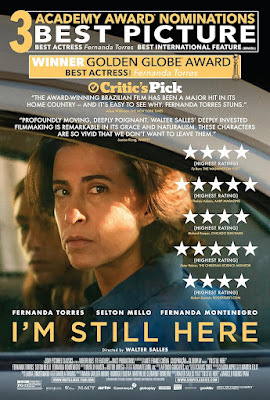
The phrase “I’m Still Here” has many uses. It’sthe title of several songs: one of my favorites is from Stephen Sondheim’s Follies,a salute to a theatrical trouper who’s lived through good times and bum timesand still refuses—at a ripe old age—to give up on her career dreams. It hasalso been used to title several films. One, from 2010, is Casey Affleck’smockumentary starring Joaquin Phoenix as a version of himself who’s on thebrink of leaving acting in order to become a hip hop artist.
But surely the most powerful I’mStill Here is the 2024 film by a Brazilian master, Walter Salles. (Itsoriginal Portuguese title is Ainda Estou Aqui .)The film is a biographical tribute to an actual Brazilian woman who, circa 1970, faced the loss of her husband and hercomfortable way of life to the authoritarian regime then in power. We open with a glimpse of Rubens Paiva and hisfamily romping near their home. Rubens, a former federal deputy, has made a comfortablelife for his large family. On one of Rio’s sun-kissed beaches they all pose forsnapshots, toss around a beachball, andsome of the kids make friends with a stray dog. Later they cross the road totheir large, comfortable house, where a sumptuous meal awaits. As the materfamilias,the slim and effortlessly elegant Eunice Paiva oversees everything with gentlegrace.
But from the start there arerumblings of more serious matters. One of the family’s teen daughters,returning from the movies with rambunctious friends, runs into a militarycheckpoint at which obedience to the powers-that-be is no joke. And soon thereafter, Rubens is picked up bythe authorities to be questioned about his secret commitment to the outlawedpro-democracy movement. He is never seen or heard from again.
This leaves it to Eunice tomaintain the household equilibrium while struggling to get news of her husband’splight. This is made all the harder becauseshe has never been clued in to Rubens’ clandestine political activities. At onepoint she is arrested herself, and held for twelve days under sordid conditions.Once she is released, it falls to her to comfort the youngest children whilebeing clear-headed enough to plan for everyone’s immediate future.
A key concern, of course, ismoney. Eunice regretfully dismisses theloyal household help and sets about selling the family residence. The plan isto move to her home city, São Paulo,where family members still live. The surprise is how Eunice evolves over thecourse of the film. We discover, after a time jump, that in 1973 she enrolledin law school, graduating at age 47 and becoming—following the country’s returnto democracy—an expert on civil rights law, nationally admired for championingindigenous people. The film takes us to the year 1996 and then 2014, trackingthe life of this tenacious woman.
It's a remarkably multi-dimensionalrole, and Fernanda Torres is up to the challenge. The Rio de Janeiro-borndaughter of two actors, she surprised many in Hollywood by taking home a GoldenGlobe for Best Actress in a Drama. When this year’s Oscar nominations wereannounced, she was include on a list of five nominees—including Mikey Madison, DemiMoore, and Cynthia Erivo—up for Best Actress. It’s rare indeed to be nominatedfor a foreign language film. The last Brazilian actress on this list was Torres’own mother, Fernanda Montenegro, for Salles’ 1998 Central Station. (Nowin her 90s, Montenegro played her daughter’s long-lived character in the film’svery last scene.)
July 15, 2025
The Family That Gays Together . . . “The Birdcage”
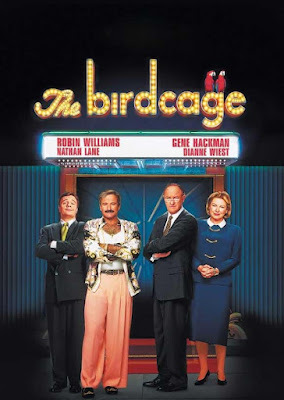
The strange, sad death ofGene Hackman somehow led me to re-watch a movie that is joyous and full oflife. The Birdcage, which pokes genial fun at intolerance of all kinds,seemed a good antidote for an era in which being different is often considereda crime. How ironic that a man who died alone, cut off by circumstance from hisloving helpmeet and his pets, is one of the stars of a film whose theme song isSister Sledge’s exuberant “We Are Family.”
La Cage aux Folles started out in 1973 as a popular French stage farce. Fiveyears later it became a French-language film, sometimes billed internationally asBirds of a Feather, that racked up international fans and awards(including three Oscar nominations) and later gave rise to two sequels. By 1983it had been transformed into an English-language stage musical with music andlyrics by Jerry Herman (Hello, Dolly!) and a book by the always madcapHarvey Fierstein. It took until 1996 for an English-language film to surface. TheBirdcage, as it was called, marked the reunion of one-time comedy duo MikeNichols and Elaine May. He directed and she wrote the saucy screenplay for anadaptation that changed the film’s setting from Saint-Tropez to Miami’s SouthBeach but maintained its lively, lovable spirit.
Hackman plays a U.S. Senatorwith impeccable Conservative credentials. A co-founder of something called The Coalitionfor Moral Order, he’s a big believer in mom, apple pie, and conventionalsexuality. What he doesn’t know is that his daughter’s intended was raised in ahousehold headed by two gay men. To make matters worse, when he and hisagreeable wife (Dianne Wiest) head down to Florida for a meet-the-parentsvisit, the press is in hot pursuit, because his close political crony has justbeen caught in a deeply humiliating scandal. (Sex with an underage prostitute?Check. And does she happen to be African-American? Check.)
With all this going on,long-time partners Armand (Robin Williams) and Albert (Nathan Lane) are redoingtheir home décor to suggest to their visitors that the family couldn’t be moreconventional, and that they have nothing at all to do with the drag club on theground floor. Armand, who dresses well and has a neat little mustache, feels hecan certainly carry off a masquerade as a straight man. Albert, though, is abit of a problem. Flamboyant and emotional, he wants to be present for theyoung lad he considers his son, but there’s no good way to conceal hissexuality. This is the rare film in which the always-vivid Robin Williams stepsaside and lets someone else take center stage. Broadway darling Nathan Lanereturns the favor by presenting a master class in role-playing. As theglamorous Starina, he headlines the shows at the Birdcage, but remaking himselffor the approval of Hackman’s U.S. Senator turns out to be a lot more of achallenge. There’s a priceless scene in which Armand coaches him to ramp up hismachismo, à la John Wayne, but of course this proves impossible. After a lot ofchaos, some of it involving young Val’s long-absent birth mother (ChristineBaranski) and a grotesquely swishy houseboy (Hank Azaria), Albert saves the dayby suddenly appearing—in a power-pink suit and pearls—as Val’s actual mother, agenteel and sensible sort who quickly wins over Hackman’s politician, sincethey seem to share similar values.
It's then that the pressdescends, for a slam-bang conclusion in which the now-united couples work tosave Hackman’s reputation as a leader of the moral majority. Fun!
July 11, 2025
“Ferris Bueller’s Day Off”: A Holiday for an Early Tech Bro
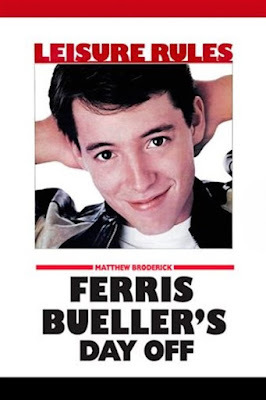
Today someone close to me gotrear-ended on an L.A. freeway. Thankfully, no one was hurt, but he’s nowmourning the damage to his late-model luxury car. And I can’t say I blame him.A well-designed automobile can be a thing of beauty, and I can’t laugh off theminor damage to a previously blemish-free chassis. All of which is making meponder the film I just re-watched this past weekend, the 1986 John Hughesclassic, Ferris Bueller’s Day Off.
Ferris Bueller is a comedy with appeal for the teenage kid in all ofus. This story of a suburban high school senior (Matthew Broderick) who decidesto go AWOLfrom his scholastic obligations makes the adult world seem prettydreary indeed. His teachers are automatons, going through the motions ofpresenting facts to their thoroughly-bored charges. The school principal(buoyed up by his dim-witted secretary) is a beady-eyed prig whose personalvendetta against Ferris leads him into actions that are downright psychopathic.Ferris’s parents, well-meaning though they might be, are too caught up in theirprofessional lives to really understand their rambunctious son, and too lovingto ever suspect him of being the con artist he is. (They are, though, all toowilling to suspect his highly volatile sister—Jennifer Grey—of making trouble.)
Ferris has never forgiven hissister for getting a car as a gift, when he himself “only” received a computer.But it’s his creative computer skills, along with his talent for mischief, thatallows him to fake illness and then round up two friends for a thoroughlyunauthorized daytrip to Chicago. Their vehicle of choice is a cherry-red low-mileage1961 Ferrari 250 GT California Spyderbelonging to the dad of his best buddy, Cameron. We never meet this father, buthe seems to signify all that is wrong with American adulthood: his possessionsapparently mean more to him than his son, who is as timid as Ferris is bold.
On their breakneck adventure to the big city,Ferris and the others bring their youthful exuberance to the world ofgrown-ups. They lunch in a swanky restaurant, have prime seats at a ChicagoCubs game, caper through the world-famous Art Institute, and wind up at aGerman-themed street parade where Ferris finds his way onto a float, leadingthe crowd in a chorus of “Twist and Shout.” Meanwhile, the fate of that Ferrariremains in question, because we in the audience know (as Ferris and his friendsdo not) that a couple of scruffy parking lot attendants are taking itjoyriding, And, since Ferris’s idea that the odometer can be re-set if the caris run backward doesn’t actually work, Cameron arrives home in a state ofpanic. I will not go into the ultimate fate of the car, but it seems that hisdeep-rooted fear of his father is about to undergo a major metamorphosis.
What will happen to theseyoung characters when they too arrive at adulthood? College is in their future,but none of them seems to have clear-cut goals, nor even any interests beyondhaving a good time. We know that all three are approaching a turning point, butwhere they’ll go from here is hardly obvious. Cameron may (or may not) bedeveloping some courage. Sloane (the only girl of the trio) is clearlysmitten, ready to go wherever Ferris maylead. As for Ferris himself, he’s too smart and too crafty to let the adultworld cut him down to size. I see him as an early incarnation of a tech bro,the potential Elon Musk of his generation.
July 8, 2025
Fiddlers on the Roof: The Laemmles Bring Art-House Movies to Angelenos
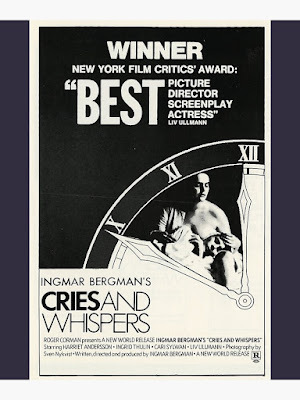
Motion picture buffs probablyknow something about Carl Laemmle (1867-1939), the German-born Hollywoodproducer who helped found and run Universal Studios. In 1915, he opened the world’s largest movie productionfacility in what has come to be called Studio City, just over the Cahuenga Passfrom Hollywood, California. As a producer he was chiefly known for classicsilent and early sound horror flicks, among them Dracula and Frankenstein(both 1931). As everybody’s “Uncle Carl,” he was later revered for saving scoresof family members and one-time Jewish neighbors from the Nazis by sponsoringtheir emigration to the U.S.
There’s a venerable movietheatre on Santa Monica Blvd. in West Los Angeles that devotes one lobby wall tomemorabilia from the life and career of Carl Laemmle. That’s not surprising,because the Royal is the flagship of the Laemmle theatre-chain, knownthroughout the L.A. area for presenting independent and foreign-language moviesthat might well be overlooked by big multiplexes where the Hollywood studioshave box-office clout. (The official Laemmle Theatre motto is “Not afraid ofsubtitles.”) The Laemmle chain was founded in 1938 by Kurt and Max Laemmle,cousins of Carl and themselves immigrants from Germany. In the early 1970s,when my boss Roger Corman decided to distribute Ingmar Bergman’s extraordinary Criesand Whispers and Federico Fellini’s delightful Amarcord toAmerican audiences, I remember Max and his son Robert showing up at a localscreening-room to check out the films and help make plans for their local andnational release. No question: these guys really loved films by Europeanmasters. Over the years they introduced to L.A. audiences such super-hits as LaCage aux Folles, as well as offbeat films by Martin Scorsese and otherAmerican masters.
The Laemmle chain is stillvery much an all-in-the-family venture, now headed by Robert’s son Greg. He haspresided over the theatres in a difficult era, coping with the challenges posedby streaming and (yes!) the pandemic, a time when public venues like moviehouses were closed for over a year. Probably to raise everyone’s spirits, Gregand company kept updating the Royal’s pandemic-era marquee, using actual movietitles to comment on the situation. Films that were supposedly “now playing”included Mask and Requiem for a Dream, while among the promisedfilms that were “coming soon” was The Awakening.
Today Greg Laemmle, who justprior to the pandemic had seriously considered selling the theatre chain,continues to run it. Which means that art-film lovers across the L.A.megalopolis can still feast their eyes on foreign movies, quirky movies, andthe occasional revival of a golden oldie. Following some pandemic-relatedadjustments, there are now seven locations throughout SoCal, including mybeloved Monica Film Center, where the Laemmles annually screen Fiddler onthe Roof on Christmas eve. (Costumes are encouraged, and everyone isinvited to sing along.)
A fairly new feature ofLaemmle World is a video podcast, “Inside the Arthouse,” which offers aninsider’s perspective on today’s art cinema. It’s co-hosted by Greg Laemmle andveteran actor Raphael Sbarge, who has recently turned to directing. (His 2019documentary, Foodways, was nominated for an Emmy.) Sbarge’s 2022documentary, Only in Theaters, chronicles the story of the LaemmleTheater chain, with special attention to those tough pandemic years. For methere’s a quiet personal joke in Sbarge’s deep involvement with the Laemmletheatres. Back in 1993, he starred for Roger Corman in a gory but lucrativecreature-feature, Carnosaur, which was explicitly designed (how well Iremember!) to beat Spielberg’s Jurassic Park into theatres. That’s oneCorman movie I suspect never played on a Laemmle screen.
July 4, 2025
Comedy the Jean Arthur Way

Effervescent blonde Jean Arthur isbest known for three Frank Capra films she made in the late 1930s: Mr. DeedsGoes to Town (1936), You Can’t Take It With You (1938), and Mr.Smith Goes to Washington (1939). Though she occasionally starred in dramas(and ended her career in a classic 1953 western, Shane), she was bestknown as the star of outrageous comedies. Of course I’ve seen her best-knownfilms, but my local library has a nifty compilation of comic gems, Icons ofScrewball Comedy (volume 1). I brought it home because I was interested in re-watchingMy Sister Eileen, starring Rosalind Russell and Janet Blair. But the twostandouts of the collection both featured Arthur: 1935’s If You Could OnlyCook and 1940’s Too Many Husbands.
If You Could Only Cook is aclassic Depression-era film, in which a wealthy, pedigreed automobile designer—suddenlyunemployed because of an idealistic stand at a board meeting—allows himself tobe persuaded by Arthur’s out-of-work Joan Hawthorne that the two of them,posing as a married couple, should apply for a job as cook and butler for a pairof thugs (Leo Carrillo and his gravel-voiced enforcer, Lionel Stander)Fortunately, Joan really can cook –so much for that catchy title—but HerbertMarshall’s Jim needs to sneak home to his mansion to get on-the-jobinstructions from his own loyal retainer.
Since this is a Depression comedy,the wealthy don’t come off very well, but leading man Marshall seems muchimproved by the time he spends slumming. He and Arthur have some great comicscenes in which they must work out who’s going to sleep where, but ultimatelyhe’s all too ready give up his stuffy fiancée and (of course!) make a life withthe thoroughly middle-class Arthur. That’s after she’s packed off to jail following a good-hearted misunderstanding.(In 1930s flicks, there’s often a lot of jail time.)
By 1940, social issues were notquite so front-and-center. But the screwball trend persisted. In Too ManyHusbands, Arthur is Vicky Lowndes, married to Melvyn Douglas’s businessmanHenry Lowndes, since six months after her first husband, Bill Cardew (FredMacMurray) disappeared at sea. The new marriage seems to be going swimmingly,though Vicky is perturbed when Henry removes the name of his presumably-dead bestfriend and business partner from the door of an office suite they once shared.But, wouldn’t you know? On the very day that the name disappears, Bill turnsup. Not knowing about the change in his wife’s marital status, he of course figures that their connubiallife will resume immediately.
Too Many Husbands sets up animpossible situation, and then waits to see how the characters will solve it.What’s interesting is that Arthur’s Vicky has no wish to choose between twoworthy but very different men. There’s a moment midway through the film wherewe clearly see it in her face: this is going to be fun! In 1940, a ménage à trois was notsomething that could be publicly endorsed, but the final scene – Vicky dancingsimultaneously with both men in a nightclub—hints that something of the sort isperhaps a possibility. (To be fair, there’s a Noel Coward play and pre-codemovie, Design for Living, with a rather similar ending.)
Early in her career, Jean Arthur wasadvised to quit show business, becauseshe just wasn’t sexy enough. Personally, I find her pert and adorable, a big improvement over the classic vamps who are trying so hard to get our attention.And she can cook too!
July 1, 2025
Brush Up Your Shakespeare: Hamlet Goes Hollywood
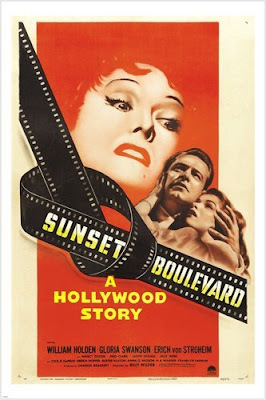
As an avid theatre-goer, I’venoticed lately that major stage productions seem to be relying more and more oneffects that can only be called cinematic. In the early years, the motionpicture industry was clearly envious of the public prestige enjoyed by livetheatre. Broadway plays and Broadway stars were quickly snatched up byHollywood, and it’s remarkable how many movies of the Thirties and Forties (inparticular) focus on stage-based plotlines. See, for instance, Busby Berkeleygems like Forty-Second Street, Gold Diggers of 1933, and FootlightParade, all of which pretend to be about the staging of Broadway musicalextravaganzas, although the numbers they contain (full of fancy overhead shots,for instance) could only have been made on a soundstage.
That was then. Now Broadwayhas discovered that playgoers willing to shell out the big bucks to see a showin person appreciate flashy cinematic touches. I recently saw the touringcompany of Harry Potter and the Cursed Child, and was impressed byits many magical moments. This was skillfully handled stage magic,though (disappearances, transformations, pyrotechnic effects, and so on), andthus was thoroughly a part of theatrical tradition. But several award-winningshows on Broadway right now feel justified by their subject matter forintroducing video in heavy doses to the stage production. I have to confessthat I haven’t seen either one, so I can’t comment on how successful theseexperiments might be. Nonetheless . . .
Good Night, and Good Luck is an historical drama about the very public conflictbetween venerated newscaster Edward R. Murrow and the notorious Senator JosephMcCarthy. George Clooney, who directed and co-wrote the 2005 film, makes hisBroadway debut in the Edward R. Murrow role. Because the play has a great dealto say about news reporting and about the impact of television on the Americanpublic, it’s perhaps not surprising to learn that it culminates in a videomontage of updated archival footage that includes the destruction of the WorldTrade Center and the January 6 attack on the U.S. Capitol.
More film-centric, of course,is the current revival of Andrew Lloyd Webber’s musicalized Sunset Boulevard,for which the talented but (I would argue) under-age Nicole Scherzinger justwon an acting Tony. The 1950 movie drama about a fading film star, directed byBilly Wilder with a remarkable Gloria Swanson in the leading role, hasnaturally led to a stage production that is all about movies and movie-making.As the L.A. Times reviewer put it, in this production “the camera is undeniablyking. The darkened stage, swathed in movie projector fog, seems like a studioset in which dreams are manufactured through live projections along with moretraditional Hollywood means.” Live camera feeds are used at times tofollow the actors, and this Norma Desmond, up there on the stage, definitelygets her close-up.
Then there’s the new Hamlet,adapted and directed by Robert O’Hara, appearing now at L.A.’s MarkTaper Forum. For much of its length it is a somewhat traditional Shakespeareantragedy, though drastically cut and highlighting anything potentially raunchy.Then everything implodes into a behind-the-scenes noir with a gumshoewho’s a blend of Sam Spade and Benoit Blanc investigating who did what to whom,on behalf of the suits at the Elsinore Film Corporation. Why? I don’t rightlyknow. It’s fun to see the spilling out of secrets not in Shakespeare’s originaltext, and I liked some of the inevitable cinematic touches (like the appearanceof Hamlet’s father’s ghost on a huge screen). But what does it add to Hamlet?Really, not much at all.
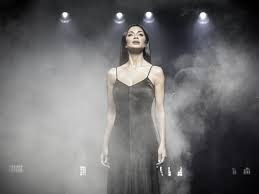 Nicole Scherzinger in Broadway's Sunset Boulevard
Nicole Scherzinger in Broadway's Sunset Boulevard
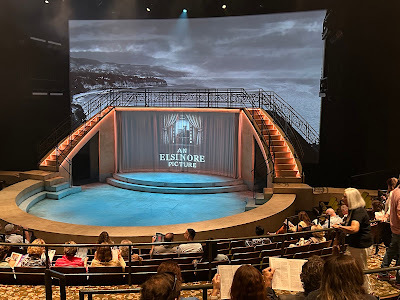 "Hamlet" at L.A.'s Mark Taper Forum
"Hamlet" at L.A.'s Mark Taper Forum
Beverly in Movieland
- Beverly Gray's profile
- 10 followers



